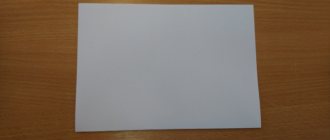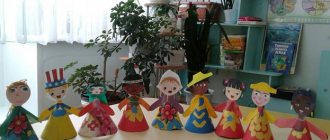Goals of learning to create crafts from waste material in kindergarten, specific tasks and techniques
Waste construction is a productive activity based on creative modeling using a wide range of non-traditional materials to give new life to the world of things that are usually thrown away.
The main goals of designing from waste material are the development of children's creative, intellectual and artistic abilities, as well as environmental education.
By making a variety of crafts (toys, furniture, vehicles), children learn to find unexpected uses for specific waste materials: plastic bottles and plates, containers for Kinder surprises, lids, corks, computer disks, packaging boxes, candy wrappers, polystyrene foam, foam rubber, etc. .
By making a variety of crafts, children learn to find unexpected uses for specific waste materials.
In the process of children constructing crafts from waste materials, teachers strive to achieve the following tasks:
- Three to four years: introduce children to the interesting possibilities of unusual materials (foam rubber, polystyrene foam, plastic bottles, etc.);
- learn to use plasticine, glue, wire, threads, etc. to connect parts and pieces;
- develop fine motor skills.
- develop cognitive and research activities;
- teach children to coordinate their actions in the process of collective work;
By creating original crafts from waste materials, children develop creative thinking.
Techniques for teaching design from waste material are traditionally built on an imitative basis and have their own characteristics at different stages:
- Stage one - detailed analysis of a sample of the future product:
- in the younger group, a craft made in advance by the teacher is used as a model;
- in the middle group, children can be asked to look at a picture or drawn image;
- at the age of six, children are already able to analyze the diagram or model of a toy; the analytical activity of children includes identifying the main parts of the toy and the material from which it is made, discussing clarifying questions, for example: what material for the craft can still be considered;
- what options for fastening parts will be optimal;
- what additional techniques can be used to design details, for example, modeling from plasticine, drawing with felt-tip pens, pencils, paints or applique elements.
- Stage two - children are taught to plan and think about step-by-step progress towards a goal, and are taught a holistic perception of the entire work process. It is specified in what sequence the parts are made, from what material, and which tool will be preferable. The choice of pedagogical techniques is carried out taking into account the age of the children:
- in younger groups, the teacher demonstrates in detail all the stages of constructing a craft, accompanying it with clear and detailed comments;
- in the middle group, the teacher gradually reduces the process of full demonstration and detailed explanation, involving active work with diagrams and supporting plans in the form of schematic sketches drawn by the children themselves.
- Stage three - the method of fastening parts and parts of the structure is thought out:
- in the middle group, plasticine is used as a connecting material;
- older children use glue, thread, wire, etc.
- Stage four provides for children to independently select the necessary material and tools for work.
- Stage five - children independently cope with the entire process of making crafts, from the emergence of a mental prototype of a toy to the substantive embodiment of a creative idea. At this stage, it is important to encourage the manifestation of creative imagination and the child’s desire for independence in the process of practical implementation.
- Stage six - summing up, analysis and evaluation of finished products. It is important to find positive aspects in the work of each child, support and inspire. An excellent technique at this stage would be an exciting role-playing or theatrical game using toys made by children, this will help them feel the significance of their work.
Older preschoolers can independently cope with the process of preparing parts
Additional tools
For successful work, it is important to prepare everything you need in advance. Traditionally, “waste” creativity uses:
- scissors;
- glue gun;
- scotch;
- hole punchers, pliers, round nose pliers,
- needle, thread
The list of auxiliary materials, of course, can be continued. The main thing is to prepare everything in advance so as not to be distracted while working.
Senior Destad group
Crafts made from waste materials for older children and toys of a more complex level:
My house. Make an imitation of your home from boxes with appliqué, adding interesting details reminiscent of familiar interiors (curtains, lamps, beds, ladders).
Traffic light. Use matchboxes and add colored paper.
Fruit table. Cut different fruits and vegetables from foam rubber, cutting off corners and sharp edges.
Snowmen. Make rounded blanks from foam rubber and supplement them with paper elements.
Blue carriage for Gena and Cheburashka. Connect pre-made boxes-cars, make wheels from bottle caps. Paint the train or decorate the carriages with appliqué.
Snowdrops. Make flowers from sticks and candy wrappers, tying them with thread.
Boxes-typewriters. Cover different boxes with paper wheels and bodies, write the name of the car brand, add appliques and modeling.
Gymnasts. Make figures from flexible wire wrapped in PVC. Roll colored paper on top and paint the faces of the gymnasts.
City at Christmas. You can make a large-scale model of a town with towers, houses, shops. For this purpose, juice bags, spray paint, markers and glue will come in handy.
Cloth
You can also make interesting and funny clothing models from waste - DIY crafts from waste material. Make a dress for a girl from newspapers, bags, cups or plates. Do fittings, catwalks and fashion shows, it’s fun and greatly develops the imagination of future fashion designers, teaches outside-the-box thinking.
How to make craft clothes from recycled materials or disposable tableware:
- first build a base of fabric or paper;
- stick on the decor parts;
- lay out the skirt using large pieces;
- the parts should be placed on top of each other diagonally so that the edges overlap;
- make “flashlight” sleeves from bent plates;
- Lay out the top layer of the dress with spoons, gluing them in layers (it’s better not to use forks, so as not to get scratched).
You can also make good dresses from canvas bags, as do crafts from garbage. You can make a whole theatrical production with actors in the roles of the goblin, the Scarecrow, the Woodcutter, and forest animals. The main thing is to have the basics in the form of shorts and T-shirts, the rest of the details are laid on top.
Now you know what crafts can be made from waste material for kindergarten. Do not limit the imagination of children, who will definitely get carried away by creativity. Crafts are a second life for unnecessary things for school and home. If they start generating their own ideas, then the day has not been wasted!






